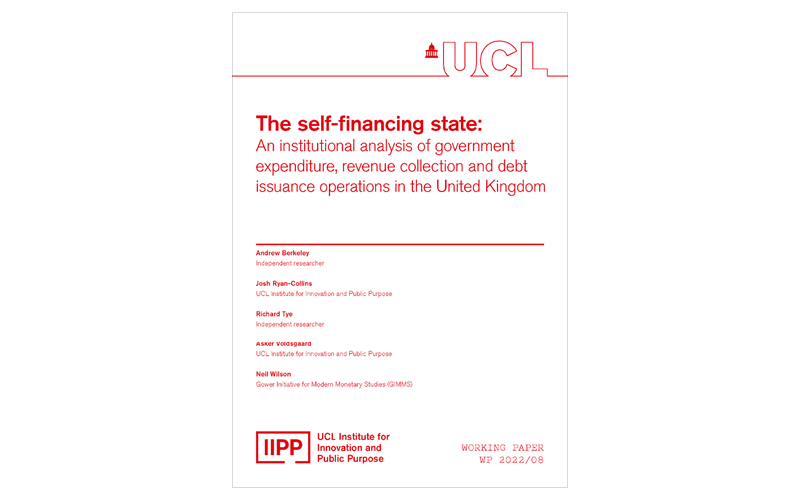The self-financing state: An institutional analysis
This paper is an institutional analysis of government expenditure, revenue collection and debt issuance operations in the United Kingdom.

24 May 2022
UCL Institute for Innovation and Public Purpose (IIPP) Working Paper Series: IIPP WP 2022/08
Authors:
- Josh Ryan-Collins | UCL Institute for Innovation and Public Purpose
- Asker Voldsgaard | UCL Institute for Innovation and Public Purpose
- Andrew Berkeley | Independent researcher
- Richard Tye | Independent researcher
- Neil Wilson | Gower Initiative for Modern Monetary Studies (GIMMS)
Reference:
Berkeley, A., Ryan-Collins, J., Tye, R., Voldsgaard, A. and Wilson, N. (2022). The self-financing state: An institutional analysis of government expenditure, revenue collection and debt issuance operations in the United Kingdom. UCL Institute for Innovation and Public Purpose, Working Paper Series (IIPP WP 2022-08). Available at: https://www.ucl.ac.uk/bartlett/public-purpose/publications/working-paper....
Abstract:
This paper constitutes a first detailed institutional analysis of the UK Government’s expenditure, revenue collection and debt issuance processes. We find, first, that the UK Government creates new money and purchasing power when it undertakes expenditure, rather than spending being financed by taxation from, or debt issuance to, the private sector. The spending process is initiated by the government drawing on a sovereign line of credit from the core legal and accounting structure known as the Consolidated Fund (CF). Under directions from the UK finance ministry, the Bank of England debits the CF’s account at the Bank and credits other accounts at the Bank held by government entities; a practice mandated in law. This creates new public deposits which are used to settle spending by government departments into the economy via the commercial banking sector. Parliament, rather than the Treasury or central bank, is the sole authority under which expenditures from the Consolidated Fund arise. Revenue collection, including taxation, involves the reverse process, crediting the CF’s account at the Bank. With regard to debt issuance, under the current conditions of excess reserve liquidity, the function of debt issuance is best understood as a way of providing safe assets and a reliable source of collateral to the non-bank private sector, insofar as these are not withdrawn by the state via quantitative easing by the Bank of England. The findings support neo-chartalist accounts of the workings of sovereign currency-issuing nations and provide additional institutional detail regarding the apex of the monetary hierarchy in the UK case. The findings also suggest recent debates in the UK around monetary financing and central bank independence need to be reconsidered given the central role of the Consolidated Fund.
 Close
Close

